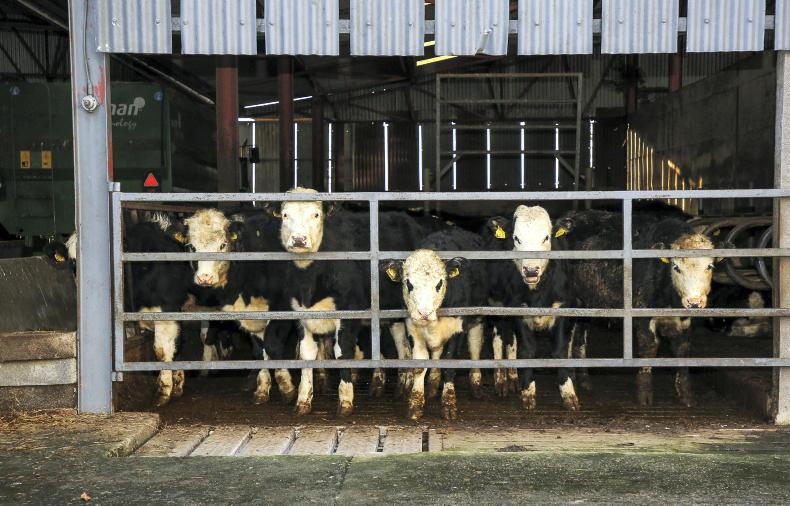With beef finishing margins extremely tight, there is no room for error or poor performance in any beef system.
This is particularly true in a dairy-calf-to-beef system.
A prolonged period of poor performance or what is often referred to as a store period will have a severe impact on animals’ ability to hit weight targets and will significantly increase the costs to get that animal finished at the other end.
This is especially true for farmers in a 19- to 20-month finishing system. The idea in this system is that most animals are slaughtered off grass at the end of the second grazing season. If target weights are not met along the way, this will mean housing, which will increase costs significantly. Many of the Thrive programme farmers have gone down this road as housing space is limited on farms and they don’t have the option of housing animals for a second winter. This means that on these farms, it’s even more important to hit targets along the way.
The target is to have bullocks at 353kg and heifers at 338 kg on 11 March at turnout.
Before animals are housed, it’s important that they come into the shed healthy. Housing can be a stressful time for weanlings, so it’s important that all vaccinations are up to date and that weanlings have been adequately dosed for both lung and stomach worms up to that point. Feeding some meal outdoors prior to housing is a good way of taking some of the stress out of housing. If animals are slow to feed when housed, it will mean a week or more of weight gain lost.
Lying and feeding space is important. Weanlings over 275kg will need 2-2.5m2 in slatted accommodation and up to 4m2 in loose bedding accommodation.
That means in a standard 4.8m bay shed with a 3.8m slat you can comfortably fit seven to eight weanlings per pen.
Cramming too many weanlings into a pen can lead to poor weight gains and reduced animal intakes. Coupled with this, feeding space is also very important.
For weanlings over 275kg that are being fed concentrates along the feeding barrier, you need to allow 400-500mm per head to have comfortable feeding space. Other things to pay attention to are to make sure that drinkers are working correctly and kept clean on a daily basis.
It’s important that there is correct ventilation in the shed and sufficient inlets and outlets for air movement.
Low-level draughts should be eliminated as much as possible.
To achieve optimum performance, weanlings should be dosed for fluke, worms and lice after housing.
If pneumonia has been an issue on the farm in the past, a vaccination programme should be discussed with your vet with details of what to vaccinate with, what animals to target and when to vaccinate them.
Clipping of weanlings can help to keep cattle cleaner and it can also help in reducing the lice burden on cattle.
With a target weight gain of between 0.6kg/day and 0.8kg/day over winter, getting the weanlings’ diet right is key.
Silage quality is vital in dairy-calf-to-beef systems and has a major role to play in reducing costs on finishing farms. The target should be to make 75 DMD silage to maximise liveweight gain and reduce costs as much as possible.
This will mean making sure you get to graze off silage fields in early April and aiming for a May cut before grass heads out.
Reseeded pastures will have a better chance of producing high-DMD silage. Aim to feed ad-lib but try to feed fresh silage every day, avoiding any old silage build-up that might reduce intakes.
In terms of ration, try and keep things simple. Aim for 14-16% protein content in the ration. While Soya bean meal will be more expensive, it’s a very good-quality protein for weanlings.
The ration should have a good inclusion rate of cereals and make sure to enquire as to the energy content of the ration.
Energy is more important than protein when it comes to performance. Ration can be restricted back to 0-1kg/day prior to turnout to avail of compensatory growth and acclimatise the weanling back to a forage only diet.
Keeping an eye on animal performance is vital. Weanlings should be weighed regularly to assess performance.
Without weighing, it’s hard to know what performance is. If you don’t identify poor performance, the same mistakes will be repeated, so weighing is critical.
This year sees the launch of the dairy-calf-to-beef weighing scheme, under which farmers will get paid €20/head up to a maximum of 20 calves.
The calves can be male dairy x dairy calves or male and female beef x dairy calves. Calves must be born after 1 January 2021 and must be at least 10 days in the herd before they are weighed. Calves must be at least 12 weeks of age at weighing. Funding of €5m has been set aside for this scheme in 2021.






 This is a subscriber-only article
This is a subscriber-only article











SHARING OPTIONS: